- Mammutidae
-
Mammutidae
Temporal range: 28.4–0 Ma Miocene to pleistocene or holocene
Mounted mastodon skeleton, Museum of the Earth Scientific classification Kingdom: Animalia Phylum: Chordata Class: Mammalia Infraclass: Eutheria Superorder: Afrotheria Order: Proboscidea Family: †Mammutidae
Hay, 1922Genus †Mammut
†ZygolophodonMammutidae is a family of extinct proboscideans that lived between the Miocene to the Pleistocene or Holocene. The family was first described in 1922, classifying fossil specimens of the type genus Mammut (mastodons), and has since been placed in various arrangements of the order. The name mastodon derives from Greek, μαστός "nipple" and ὀδούς "tooth", as with the genus, to indicate a characteristic that distinguishes them from allied families. The genus Zygolophodon has also been assigned to this family.
Mammutidae classifies taxa that are known by the common name mastodon, a name also used by Georges Cuvier for the genus edit] Classification
The family diverged from a common ancestor of the Elephantidae, which includes the extinct genus Mammuthus, the mammoths, and extant species of Elephas and Loxodonta, the modern elephants.
The author of Mammutidae also published Gomphotheriidae, which also includes species previously described as Mastodon. The classification of proboscideans is unstable and frequently revised, relationships within the order are controversial, and it is incompletely summarised as:
- Elephantimorpha (Proboscidea)
- Elephantida
- Elephantidae (elephants and mammoths)
- Gomphotheriidae (gomphotheres)
- Mammutida
- Mammutidae (mastodons)
- Mammut
- Zygolophodon
- incertae sedis
- Eritreum
- Mammutidae (mastodons)
- Elephantida
Some earlier descriptions of specimens as Mastodon have been transferred to the two genera of Mammutidae.
References
- Classification of the Mammutidae Paleobiology Database.
External links

This prehistoric mammal-related article is a stub. You can help Wikipedia by expanding it. - Elephantimorpha (Proboscidea)
